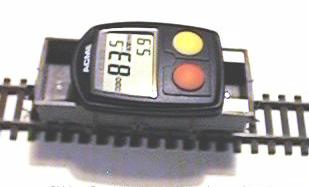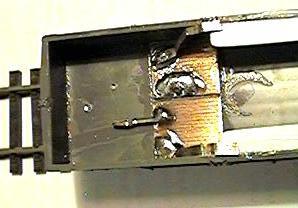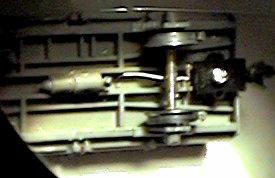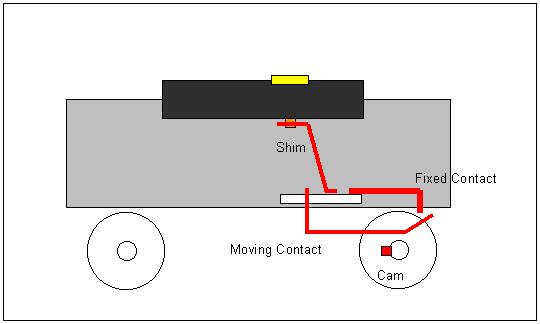
A Scale Speedometer for your Railway
copyright Bob Backway 1999
Back to Non DCC Articles Menu
Introduction
I had been aware of several "non-standard" applications for bicycle speedometers for some time. Articles have already been written on using bike speedos as scale speedos in the British "Model Engineer" and the US "Garden Railways" magazines. Recently "Silicon Chip" published an anemometer using a cheap speedo available from Safeway or Woolworths. I had already purchased a Safeway bike speedo to play with before the above articles appeared. Then at an exhibition I came across a Fleischmann HO speedo for which the owner had paid $A150. It used an almost identical bicycle speedometer! I figured I had better go out and publish a HO Rail Speedo wagon before others get ripped off.
Parts:
A Safeway/Woolworths $A12.00 Acme Cyclocomputer (no need to add water)
Small piece of PCB
Thin wire or brass shim
Thin Guitar string (spring steel)
A couple of wire wrap pins or stiff copper wire.
 Inside the wagon
Inside the wagon
Under the wagon 
Construction
Looking at the above pictures will show you how easily it is to make a speedo wagon identical in operation to the unit that sells for $A150!
The bike speedo is designed to slide onto a handle bar mount that provides the electrical connection to the wheel sender. I've replaced the mount with two strips of styrene glued to each side of, and aligned with the top of the wagon. The strips are half the length of the wagon. The speedo can be mounted by placing it at the non strip end and sliding it over the mounting strips.
The electrical connections could be simply soldered to the pins on the rear of the speedo but I chose to make crude slide contacts using brass shim. The shim was soldered to a small piece of printed circuit board glued to the bottom of the wagon and bent up so as to contact the speedo pins as it is slid into place. The PCB had been electrically split into two by cutting/grinding a gap through the copper longitudally through the centre of the PCB.
The original bike speedo used a magnet and reed switch to provide the distance pulses. While this has been successfully used (and documented) by others with applications from miniature railways to garden railways the components are far to large for HO. In this case a simple light weight cam operated switch is quite satisfactory.

Under the wagon a solid contact is provided using a gold wire wrap pin bent across the chassis rails just behind the Kadee coupler. The pin is brought through the wagon floor and soldered to one side of the PCB. Another hole passes through the other half of the PCB. A piece of guitar string is soldered onto the PCB. This spring steel wire protrudes through the floor where it is bet to fit under but just not touching the axle. It is again bent so it nearly touches the fixed pin across the chassis bottom.
Remove the wheels and solder another wire wrap pin or something similar to the axle forming a small cam. The cam should just touch the moving contact enough to cause it to brush against the fixed contact. You may have to play around with it a bit to get it working nicely. You know you have got it when the wheel spins freely and the contact can be tested by mounting the speedo and seeing if it reads.
Calibration
Calibration instructions come with the speedo. What they don't make clear is the calibration "constant" is actually the wheel circumference. To get scale speed you simply multiply the wheel diameter by 3.142 (pi) and your scale:
Calibration Number = 3.142 x D(mm) x S
For the HO Steam Era spoked wheels on this wagon:
Calibration Number = 3.142 x 10.4 x 87 = 2843
Notice that this is about the circumference of a 900mm or 36" diameter wheel!
I hope you have some fun with the speedo. It's great to educate the flat out or bust operators as to how fast they are going!
My next application for these speedos will be a ships log for my 14 foot catamaran. Wonder if I can build a depth sounder out of it?
Back to Non DCC Articles Menu©ADCC1999
14/07/99